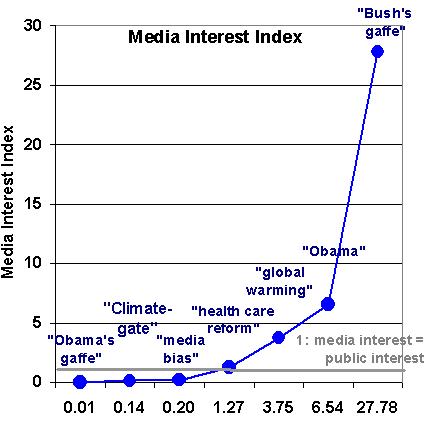The lack of coverage of Climategate by the mainstream news media over the last 2 weeks has been breathtaking. Richard North at the EUReferendum blog advanced a way to measure media bias of this kind with what he calls his “Tiger Woods Index”, where he compares the number of Google search web matches to Google search news matches. The idea is that if the media are avoiding an issue, then the number of news matches relative to web matches will decrease. If the media are overly obsessed with an issue compared to what the public is discussing on web pages, then the number of Google search news matches will increase relative to the number of web matches.
I decided to play around with this idea with searches on several names and phrases of my own. Since “media bias” is such an ugly phrase, I will characterize the resulting statistics as a Media Interest Index. I found that for issues where the news media seems to have about the same level of interest as the public, the ratio of web page matches to news page matches was somewhere in the range of 500 to 1,000.
By using a totally scientific process (since I’m a scientist) to compare the media’s interest to the public’s interest, I decided that a ratio of 1,000 would represent equal media and public interest. Please do not ask for the data I used, since I will either hide it or delete it before I give it up.
The Media Interest Index is then 1,000 times the number of news matches divided by the number of web matches. The result is 1 for equal interest between the media and the public. A value of 2 would mean the news media are “twice” as interested as the public. A value of 0.5 would mean that the media are only half as interested as the public.
See? Totally scientific.
The following chart shows the results for Google searches on several words, phrases, and names. The phrase “health care reform” is of great interest to both the media and the public, and we see a Media Interest Index value of 1.27, indicating roughly equal interest between the media and the public.

On this scale, “Climategate” has a MII of only 0.14, suggesting much less interest (about one-seventh) from the media than from the public in general. Of course, some news outlets, especially those in the UK and FoxNews, have been providing heavy coverage, so the low value is being dragged down by some other news organizations.
Similarly, the phrase “media bias” has an MII value of 0.2, indicating the rather obvious fact that the media are reluctant to do news stories on “media bias”, an issue that is of considerable interest at many non-news websites.
But there are even bigger extremes to be seen in the above chart. For instance, there seems to be a disproportionate interest of the media in “Obama”, with an MII value of 6.5. Even that, however, is not as interesting to the media as “Bush’s gaffe”, with an index value over 27!
And while “Obama” has a disproportionately large interest from the media, the interest in “Obama’s gaffe” is disproportionately small, with an MII value of only 0.01! Thus, the media seems to be about 2,000 times more interested in gaffes uttered by Bush than those uttered by Obama. Similarly, comparing the media’s interest in “global warming” to their interest in “Climategate”, the ratio of those two MII values approaches 30.
For any social scientists, pollsters, or political pundits who might object to the above analysis and would like to vent, you can contact me at idontreallycare@hotmail.com.
This research was not supported by any coal or oil company…but I wish it was.

 Home/Blog
Home/Blog



